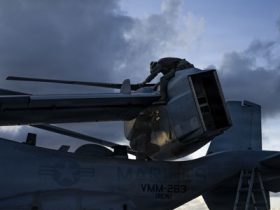Another deadly boat strike
President Trump ordered another attack on a boat in international waters, claiming that the strike killed three people who were “positively identified, extraordinarily violent drug trafficking cartels and narcoterrorists in the SOUTHCOM area of responsibility.” In his post, Trump shared a clip of an explosion but no evidence to back up his claims.
When reporters asked for proof, Trump replied, “We have proof. All you have to do is look at the cargo that was spattered all over the ocean — big bags of cocaine and fentanyl all over the place.”
Associated Press: “The Trump administration has justified the military action as a necessary escalation to stem the flow of drugs into the United States. But several senators, Democrats and some Republicans, have questioned the legality of Trump’s action. They view it as a potential overreach of executive authority in part because the military was used for law enforcement purposes.” More, here.
Some forces are being staged at Puerto Rico’s José Aponte de la Torre Airport—or as old Navy hands know it, the former Naval Station Roosevelt Roads. The War Zone has a look at the military’s new use of a facility declared surplus more than two decades ago.
Welcome to this Tuesday edition of The D Brief, a newsletter dedicated to developments affecting the future of U.S. national security, brought to you by Bradley Peniston. It’s more important than ever to stay informed, so thank you for reading. Share your tips and feedback here. And if you’re not already subscribed, you can do that here. On this day in 1944, Navy Lt. Arthur Preston led a pair of plywood PT boats into a Japanese-held harbor in Indonesia to rescue a downed pilot—an action so daring that Preston received the Medal of Honor for it.
Israel pushes into Gaza City
After weeks of buildup, Israeli forces moved into Gaza’s largest city on Tuesday night. New York Times: “Hundreds of thousands of people remained in the city with hardly anywhere to go. Israel said the ground operation, after nearly two years of war, was needed to keep Hamas militants from regrouping…Palestinians in Gaza City described scenes of panic as Israel pounded the area with heavy airstrikes, and local health officials said that more than 20 people had been killed and dozens more wounded.” More, here.
Russian drones
A new NATO quick-response effort got its first test: an air intercept of a Russian drone in Romanian airspace, officials said in a Monday press release. On Friday, a Rafale jet and a Polish helicopter were scrambled to intercept the drone, marking the first action of the alliance’s Eastern Sentry activity.
Eastern Sentry was unveiled earlier on Friday by U.S. Air Force Gen. Alexus Grynkewich, Supreme Allied Commander Europe, who described it as a response to Poland’s Sept. 9 downing of Russian drones in its airspace.
“Although the immediacy of our focus is on Poland, this situation transcends the borders of one nation. What affects one ally affects us all. This is an issue that impacts the entire Alliance, and we will treat it as such,” Grynkewich said.
Grynkewich said Britain, Denmark, France, and Germany had already deployed forces as part of the effort. He described the initiative as a “comprehensive and integrated approach” that goes beyond the case-by-case “individual air policing actions” of NATO’s previous air-defense posture.
It’s about more than air defense, an alliance official told Defense One’s Patrick Tucker on background. The official said Grynkewich met Monday with all of his domain commanders, adding: “It doesn’t just impact Allied Air Command, and it doesn’t just impact Allied Joint Force Command Brunssum, which leads integrated land command. We’re looking at this holistically along the eastern front.” Read on, here.
Such incursions reveal new asymmetric-war tactics—and the U.S. isn’t ready, argue Mick Ryan and Peter Singer in the Washington Post. “The U.S. homeland remains profoundly vulnerable to similar surprises. The looming wave of smarter drones, advanced AI and sophisticated 3D printing promises to redefine both the battlefield and how trickery is conducted upon it. And our main adversary, China, is investing heavily in these technologies while studying the lessons of Iran and Russia.” Read on, here.
And explore the duo’s past writing on similar themes for Defense One, here.
Meanwhile, companies are pitching anti-drone drones that ram or explode near incoming Shaheds. Fielding such interceptors is a priority for Ukraine, the director of the Ukrainian Defense Procurement Agency told Defense News at the DSEI trade show in London last week. Read on, here.
And the UK aims to have its own drone swarms within five years. UK Defense Journal, reporting on Tuesday: “Uncrewed systems will soon become a defining feature of the UK’s conventional forces, with Defence Minister Luke Pollard confirming that drones and unmanned ground vehicles (UGVs) will be fielded in high numbers over the next five years.” More, here.
Around the Pentagon
Army launches “venture capital”-type effort to boost innovation. “We’re really taking the approach where we’re going to deliberately make a large number of investments in emerging tech companies,” Matt Willis, the Army’s Fuze program director, told Defense News. The program brings together four funding streams: “XTech prize competitions, small-business funding, tech maturation and manufacturing technology — worth about $750 million in fiscal 2025,” Read more, here.
Will the Qatari 747 be less capable than Air Force One is supposed to be? The Air Force says work has begun on the gift to President Trump from Qatar’s rulers (who could be forgiven for wondering about its efficacy after the Sept. 9 Israeli airstrikes on their capital). Sharp-eyed Greg Hadley of Air & Space Forces magazine notes that the statement distributed Monday talks not about conversion for “presidential transport,” but “executive airlift”—which might imply a different set of requirements. Read, here.
ICYMI: The work—which Air Force leaders have said will cost some $400 million but others believe will consume more than $1 billion—is being funded with money once allocated to the Air Force’s over-budget Sentinel ICBM effort.
Read the full article here








Leave a Reply